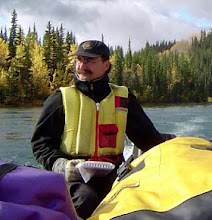 |
| L to R: Julia Morberg harvests grayling, Madeleine de Repentigny picks blueberries, JJ Van Bibber tries out beaver tail, Waylin Nagano with his first caribou |
 |
| Dänoja Zho (Long ago House) cultural centre stands beside the Yukon River, a striking architectural statement of cultural difference in the midst of the historic gold rush town of Dawson City, Yukon. |
Myth & Medium is a periodic cultural heritage event hosted by the Tr'ondëk Hwëch'in in the centre of the Yukon Territory, Canada. This year's event, We've got a story to tell..., addressed how community narratives of meaning are being looked after, passed on to youth and used in building a future.
Our host, the First Nation's heritage department, currently has nine full time staff including a director, two cultural centre programmers, an archivist/collections manager, managers for traditional knowledge, land-based heritage resources and heritage sites, a language programmer and a heritage researcher. Additional staff include a collections assistant and research assistant on contract. Summer staff look after trails and interpretation programs.
 |
| One afternoon was spent in the First Nation Hall where different land skills and crafts were set up. Mary Jane Moses demonstrates, and gets help, preparing dry meat. |
Sharon Shorty, a Tlingit/Northern Tutchone storyteller, opened the conference with a retelling of a number of traditional stories, reminding the audience of both the colour and embedded morality in these tales. The evening of films combined a selection of home movies made in Dawson in the 1930s and early 40s. They joyfully presented the details of family and community life in the still familiar landscapes of today.
Julie Cruikshank, respected anthropologist of the the Yukon, offered her recollections of her first oral history project in the mid-1970s. She interviewed two of the senior Hän elders at the time. Patsy Lindgren, daughter of Chief Isaac, spoke of her father's warnings to be ready for civilization. Julie noted that in her stories, Patsy's understanding of civilization, the arrival of the white man, was alcohol and violence.
 |
| Sue Parsons, Tr'ondëk Hwëch'in collections manager, makes willow bark rope. |
 |
| Freda Roberts, Tr'ondëk Hwëch'in Cultural Education specialist, on right and Sara Nielsen, Yukon Parks, work out the intricacies of woven babiche bags. |
A professional round table included some 40 individuals working in First Nation, Yukon and Canadian government cultural heritage roles. Discussion included technical topics on the administration of community oral history collections and the provision of training for new staff. Yukon College's Heritage and Culture certificate, specifically designed to provide a professional introduction for First Nation students, was profiled as a successful example of community-based training.
The priority for the First Nation governments attending Myth & Medium however was the teaching of youth. Mary Jane Moses of the Vuntut Gwich'in Government's heritage department presented on the extensive cultural geography research project underway and how the results were being transformed into curriculum packages for their school. She also profiled the success of their recent book, People of the Lakes, based upon the oral history projects.
In Dawson the Tr'ondëk Hwëch'in are concerned about the state of the Hän language. Jackie Olsen, Director of the heritage department, noted that while lots of work has been done to record the language over a dozen years, they have not yet produced a single speaker.
In Dawson the Tr'ondëk Hwëch'in are concerned about the state of the Hän language. Jackie Olsen, Director of the heritage department, noted that while lots of work has been done to record the language over a dozen years, they have not yet produced a single speaker.
Jackie also announced the Yukon Department of Education's accreditation of the First Nation's series of seasonal land practices camps. Students attending four of the Tr'ondëk Hwëch'in seasonal activity camps - First Hunt (caribou late fall hunt), First Fish (salmon in mid-summer), Spring camp and Moose camp (early fall) - will obtain credits for their participation.
 |
| Fran Morberg-Green draws upon her knowledge of traditional plant herbals and medicines to help people find the right path. |
 |
| The Tr’ondëk Hwëch’in Heritage Department released a 10-minute-long animation, “The Story of Crow,” created by TH youth, ages 8–10, during a Hän language demonstration project in summer, 2011. |
Making a Future
Staff of both the Dawson City Museum and the Dawson area national historic sites spoke about the need to more closely engage with the local community. Laura Mann of the DCM suggested a “rapid response” gallery for the museum, a space dedicated to reflection on current debates in the community. Carrie Docken, responsible for national historic site interpretation programs, spoke about enhancing the sites' messages by ensuring they were grounded in both the community's present and a national narrative.
Glenda Bolt, manager of Dänoja Zho, described the First Nation's interest in partnering with other community groups. The cultural centre works with the local art school and the annual short film festival to bring the First Nation and newcomer parts of the community together.
My own paper, a contribution to the Tr'ondëk Hwëch'in International Polar Year traditional knowledge project, highlighted the complexities of contact between cultures with incommensurable knowledge sets. The paper questions the casual assumption of Western culture that it is the norm which others should strive to match. We need to think more about gaining consensus instead of getting our way.
My own paper, a contribution to the Tr'ondëk Hwëch'in International Polar Year traditional knowledge project, highlighted the complexities of contact between cultures with incommensurable knowledge sets. The paper questions the casual assumption of Western culture that it is the norm which others should strive to match. We need to think more about gaining consensus instead of getting our way.
Myth & Medium called for a more respectful and reflexive response to a cultural difference. We all need stories that help clear up the bad rap of civilization.











No comments:
Post a Comment